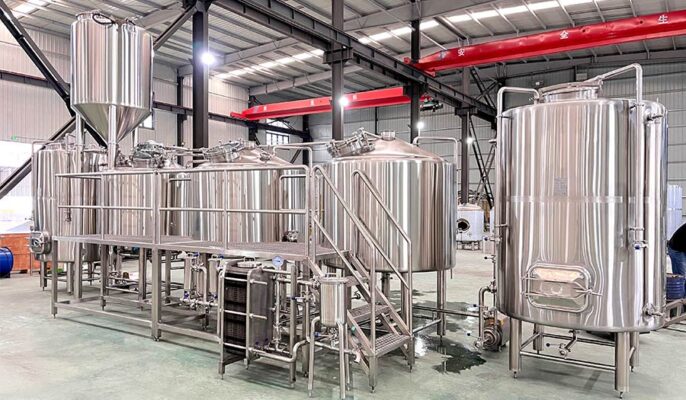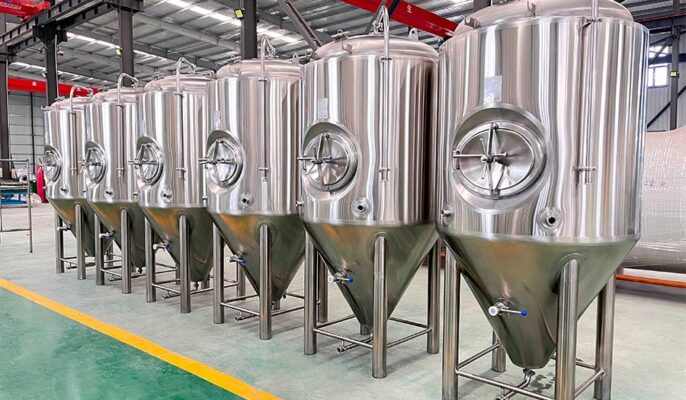L'avvio di un birrificio può realizzare il sogno di un amante della birra o di un birraio, un sogno che può essere impegnativo. Il costo di avvio di un birrificio dipende da una serie di fattori, tra cui l'ubicazione, le dimensioni, le attrezzature, le materie prime, le risorse umane e la strategia di marketing, per citarne alcuni. Per questo motivo, prima di avviare un birrificio sono necessari un business plan e un budget dettagliati per valutare con precisione l'investimento. In questa guida, gli ingegneri Micet spiegheranno in dettaglio quali sono i costi da sostenere per avviare un birrificio di successo.
Che tipo di birrificio ha scelto di avviare?
Non tutti i birrifici sono uguali e il costo delle attrezzature per la produzione di birra può variare notevolmente in base a diversi fattori, come le dimensioni del birrificio, il tipo di sistema di produzione e i componenti specifici necessari.
- Nanobirrifici: Da $1.000 a $50.000 I nanobirrifici sono più piccoli e in genere producono meno di 1.000 barili all'anno. Questi sistemi sono una scelta popolare per le start-up o i brewpub, grazie ai costi iniziali più bassi.
- Microbirrifici: Da $5.000 a $20.000 I birrifici più piccoli producono in genere da 1.000 a 15.000 barili di birra all'anno. Questi sistemi sono popolari tra i birrifici indipendenti di piccole e medie dimensioni che distribuiscono i loro prodotti a livello regionale.
- Birrifici regionali: Da $20.000 a $1.00.000 I birrifici regionali producono volumi maggiori di birra, in genere da 15.000 a 500.000 barili all'anno. Questi sistemi sono più complessi e richiedono maggiori investimenti.
- Grandi birrifici: $100.000 e oltre I grandi birrifici producono grandi volumi di birra, in genere più di 500.000 barili all'anno. Il costo di questi sistemi può raggiungere i milioni di dollari, a seconda delle dimensioni, della tecnologia e dell'automazione.

Costi iniziali di un birrificio
- Ubicazione spaziale: L'ubicazione di un birrificio è un fattore fondamentale per i costi di avviamento. I costi associati all'ubicazione possono variare notevolmente a seconda che si affitti, si prenda in leasing o si acquisti lo spazio. Ci sono costi aggiuntivi se si assume un arredatore o un installatore piuttosto che fare il lavoro da soli.
- Attrezzature e inventario: Spesso è possibile risparmiare acquistando attrezzature per la produzione di birra o forniture per bar usate, ma anche in questo caso la spesa per attrezzature nuove e adeguate (compresi fermentatori e fusti) è un impegno a lungo termine. Mentre i birrifici devono avere a disposizione cereali, luppolo e lievito, i bar devono avere a disposizione anche birra, vino e alcolici.
- licenze e permessi: le bevande alcoliche richiedono licenze e permessi per la produzione e la vendita. Anche se le tariffe variano a seconda dello Stato e della città, la licenza iniziale di solito non è facoltativa. Se avete bisogno del supporto di un professionista legale, potreste pagare centinaia di dollari all'ora.
- Assunzione e formazione del personale: La selezione iniziale del personale può costare più di quanto si pensi. Il reclutamento di manager e birrai altamente qualificati può richiedere l'utilizzo di costose piattaforme online o l'assunzione di costosi reclutatori. Pubblicare e gestire campagne di reclutamento può essere costoso.
Attrezzature per birreria Costi di avvio di un birrificio
L'attrezzatura per il birrificio è un passo fondamentale per determinare i costi di avviamento. Ecco un elenco delle attrezzature essenziali per il birrificio con i relativi costi stimati:
- Bollitori: Sono il cuore dell'attività e possono costare da $20.000 per un'unità piccola a oltre $100.000 per un sistema più grande e complesso.
- Fermentatori: Il costo dei fermentatori varia in base alle dimensioni e al materiale. Per ogni fermentatore è necessario prevedere una spesa compresa tra $2.000 e $10.000.
- Attrezzature per la macinazione: I mulini utilizzati per macinare i cereali possono costare da $1.000 a $5.000.
- Sistemi di raffreddamento: Il raffreddamento è fondamentale per il processo di produzione della birra e può variare di prezzo da $5.000 per un sistema di base a $20.000 per un sistema più grande.
- Attrezzature per il confezionamento: A seconda del metodo di confezionamento (bottiglie, lattine o fusti), i costi possono variare notevolmente. Ad esempio, una linea di imbottigliamento può costare da $20.000 a $100.000.
- Strumenti per il controllo della qualità: Per mantenere la qualità della vostra birra, avete bisogno di attrezzature di laboratorio, che possono costare da poche migliaia di dollari a più, a seconda della complessità dell'attrezzatura.
- Serbatoi di stoccaggio: Per immagazzinare le materie prime e la birra finita, sono necessari serbatoi di stoccaggio, che possono costare da $5.000 a $15.000 ciascuno.
- Pompe, tubi e valvole: Sono essenziali per spostare i liquidi all'interno del birrificio e possono costare migliaia di dollari.
- Attrezzature per la pulizia: Una corretta sanificazione è essenziale e l'investimento in attrezzature di pulizia può variare da $2.000 a $10.000.
- Sistemi di controllo per birrerie: I sistemi di automazione e controllo possono richiedere un investimento significativo, che va da $10.000 a $50.000 o più.
Fattori che influenzano i costi del birrificio
Materiali per impianti di birrificazione
- Attrezzature per la produzione di birra in rame: Le attrezzature per la produzione di birra in rame sono state utilizzate per la produzione di birra per centinaia di anni grazie alle loro proprietà. Può trasferire rapidamente e uniformemente il calore alla pentola, facendo bollire il mosto. Tradizionalmente, si è iniziato a produrre birra con utensili di rame perché questi ultimi sono molto adatti a far bollire il mosto ad alte temperature.
- Attrezzature per la produzione di birra in acciaio inox: Tutti i grandi birrifici commerciali utilizzano attrezzature per la produzione di birra in acciaio inossidabile nei tempi moderni. Anche se i bollitori utilizzati non sono completamente in acciaio inossidabile, il materiale dell'acciaio inossidabile non reagisce con le sostanze chimiche, ma reagisce con il cloro, per cui una disinfezione adeguata non influisce sulla qualità della birra prodotta con attrezzature in acciaio inossidabile. L'acciaio inossidabile è più resistente del rame, quindi il mosto non sarà stressato quando bolle ad alte temperature.
Attrezzature per la produzione di birra nuove o di seconda mano
Il costo di produzione delle attrezzature per la produzione di birra dipende anche dall'acquisto di attrezzature nuove o di attrezzature di seconda mano per l'avvio dell'attività. Naturalmente, le attrezzature nuove saranno più costose di quelle di seconda mano, ma se le attrezzature commerciali di seconda mano sono in buone condizioni, non influiranno affatto sulla produzione di birra. Le attrezzature per la produzione di birra nuove possono essere acquistate con fiducia, senza preoccuparsi di altri problemi, e possono anche essere utilizzate per un periodo di tempo più lungo.
Caratteristiche delle apparecchiature per la produzione di birra
Le caratteristiche delle apparecchiature per la produzione di birra dipendono dalle esigenze del processo di produzione e dei prodotti. Se il vostro prodotto deve fermentare a basse temperature, potreste aver bisogno di una macchina per la produzione di birra. fermentatore in grado di controllare accuratamente la temperatura. In particolare, se la birra che producete richiede un processo di ammostamento in più fasi e una fermentazione a bassa temperatura, potreste aver bisogno di un sistema di ammostamento con un controllo avanzato della temperatura. Ad esempio, se si desidera un'apparecchiatura per la produzione di birra automatizzata che consenta di risparmiare tempo e manodopera, il costo potrebbe essere leggermente superiore.

Progettazione di impianti per la produzione di birra
Il design dell'apparecchiatura non influisce solo sul suo funzionamento e sulla sua manutenzione, ma anche sull'aspetto estetico della vostra birreria. Ad esempio, potreste volere che l'apparecchiatura abbia un pannello di controllo facile da usare per semplificare le operazioni. Potreste anche volere che l'apparecchiatura abbia un aspetto unico per attirare l'attenzione dei vostri clienti. Ad esempio, se volete che l'apparecchiatura sia facile da usare, potreste volerla dotata di un pannello di controllo con etichette chiare e comandi intuitivi. Il pannello di controllo deve visualizzare tutte le informazioni importanti, come temperatura, pressione e portata, e deve consentire di regolare facilmente le impostazioni. Se volete che il vostro birrificio si distingua, potreste desiderare che l'apparecchiatura abbia un design unico. Può trattarsi di un design moderno ed elegante, con linee pulite e superfici lucide, o di un design rustico e tradizionale con decorazioni in rame e dettagli in legno.
Fornitore di attrezzature per birreria
La scelta di un fornitore affidabile di attrezzature per la produzione di birra è fondamentale per personalizzare le attrezzature. Un buon fornitore non solo può fornire attrezzature di alta qualità, ma anche servizi di personalizzazione professionali per aiutarvi a progettare e produrre attrezzature che soddisfino le vostre esigenze. Quando si sceglie un fornitore, è necessario considerare la sua esperienza, le sue capacità tecniche, la qualità del servizio e altri fattori. Ad esempio, Micet Group è un team maturo con una forte tecnologia. È in grado di soddisfare le vostre esigenze di personalizzazione sotto ogni aspetto.
FAQ
Quanto costa in genere la creazione di un microbirrificio?
Il costo di costruzione di un microbirrificio varia molto, da $1.000 per un piccolo impianto casalingo a oltre $80.000 per un birrificio commerciale, a seconda di una serie di fattori quali le dimensioni, le attrezzature e la posizione.
Quali altri costi sono associati alla creazione di un microbirrificio?
Oltre ai costi delle attrezzature, i proprietari di microbirrifici devono considerare le spese di spedizione, di sollevamento e di installazione; altre spese possono includere i permessi, la costruzione e le materie prime.
Quanto tempo ci vuole per raggiungere il pareggio quando si avvia un birrificio?
Il tempo necessario a un birrificio per raggiungere il pareggio può variare notevolmente a seconda di fattori quali la posizione, le dimensioni e la strategia di marketing. In media, un birrificio può impiegare dai 2 ai 5 anni per diventare redditizio, ma questo lasso di tempo può essere più breve o più lungo a seconda della situazione specifica.
Quali pratiche sostenibili devo considerare per il mio birrificio?
Poiché la sostenibilità diventa sempre più una priorità nell'industria della birra, è fondamentale adottare pratiche ecologiche come la conservazione dell'acqua, la riduzione dei rifiuti e l'aumento dell'efficienza energetica. Queste misure non solo aiutano a minimizzare l'impatto ambientale, ma attraggono anche i consumatori attenti all'ambiente e riducono le spese di gestione.




